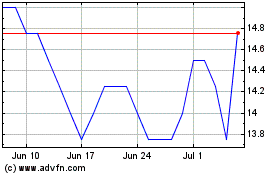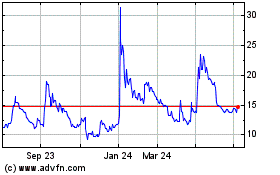TIDMAGL
RNS Number : 2963C
Angle PLC
30 April 2012
For immediate release 30 April 2012
ANGLE plc
("ANGLE" or "the Company")
Parsortix Update
PARSORTIX GEN2 SEPARATION CASSETTE - DESIGN BREAKTHROUGH
ANGLE plc (AIM: AGL), the technology commercialisation company,
is delighted to announce that it has successfully achieved crucial
new capabilities in the performance of its Parsortix cancer cell
separation device.
ANGLE has previously demonstrated that its Parsortix separation
technology can capture cultured breast cancer, prostate cancer,
lung cancer, colon cancer and ovarian cancer cells added to blood
(spiked blood) and has successfully captured circulating tumour
cells (CTCs) in prostate cancer and breast cancer patient
blood.
Capture of the very rare CTCs in cancer patient blood may enable
the development of a simple blood test to allow the:
-- prognostic assessment of patients to predict the likely
outcome of their cancer enabling a more informed consideration of
their treatment options at the outset;
-- monitoring of cancer patients during treatment to assess
their progress and determine which treatments are likely to be
effective for them;
-- post-treatment monitoring of patients in remission for early
detection of potential relapse, with the potential to improve
treatment success rates for secondary cancers.
Primarily as a result of the original design being for the
separation of foetal cells from peripheral maternal blood for
foetal health diagnostics, the first generation of Parsortix
separation technology (known as Parsortix GEN1) was limited to a
blood sample volume of circa 1ml and a flow rate of circa
0.1ml/hour. Efficacy and practicality in clinical CTC applications
requires separations of 7.5ml blood volumes in times of a few
hours.
Because of this, ANGLE has previously advised the market of a
critical and challenging objective to develop "new separation
device designs to allow ease of use in the laboratory addressing
critical factors of increasing the volume of blood that can be
screened and the speed of blood flow through the device". A related
and important issue was that GEN1 captured not only the target
cancer cells but also the patient's white blood cells (albeit in a
different location within the cassette), which are not cells of
interest in the cancer application.
Successfully redesigning the cassette to address these key
issues has been considered a major technology risk remaining with
the Parsortix development and has required a major engineering
development effort over the last six months.
Highly innovative design and manufacturing by the Parsortix
technical team and its partners has generated an advanced new form
of the cassette (GEN2). Externally GEN2 maintains the same simple
design and size, but internally the patented step arrangement has
an entirely new structure and layout.
Experimentation using the GEN2 cassettes has demonstrated a
tremendous improvement in cassette performance, surpassing our most
optimistic expectations.
The Parsortix GEN2 cassette has successfully allowed:
-- Blood sample volumes of 8ml to be separated. It appears that
substantially larger volumes of blood can be processed if required,
although this has not yet been demonstrated.
-- A flow rate of 8ml/hour to be utilised without any fracture
or damage to the target cancer cells. This meets the top end target
that we set for the device. However it appears that we may be able
to substantially increase flow rates beyond this level, although
again this has not yet been demonstrated.
-- Near complete reduction in the debris and clogging to which the GEN1 cassette can be prone.
-- Visual identification of cultured cancer cells spiked in
healthy whole blood with cancer cell capture and enumeration being
accurate to approximately 10% of the cells added for numbers of
cancer cells added of 0, 15, 200, and 2,000 cells in volumes of
blood ranging from 1ml to 8ml. Bearing in mind that there is a
level of statistical variation when adding the spiked cells into
the blood, this is indicative of complete capture of the added
cancer cells.
-- Formal identification of the added cancer cells using
industry standard immuno-staining within the cassette for
cytokeratin 18, an epithelial marker used to indicate cancer. Again
there was very good enumeration of the cells, closely in line with
the number of cells spiked in the blood.
-- Capture of the target cancer cells without capture of other
non-target cells (other than very low levels of red blood cells and
white blood cells on the periphery of the cassette) and without any
build-up of aggregate or debris, making visualisation and
identification of cancer cells even easier.
The most challenging separation so far completed was 15 cancer
cells added to 8ml of whole blood, which equates to looking for one
cancer cell in 2.8 billion other cells. Our complete success
(subject to the tolerances of counting the cells) in visually
identifying the target cells in this sample within one hour of
receiving the sample is testament to the sensitivity of the new
Parsortix GEN2 design.
We are greatly encouraged by the success of this further
development of our technology. Our technical development is
proceeding to plan and we are on track to meet the next key
milestones, which are:
-- Validation of the separation device for other cancer types;
-- Independent third party validation of the performance of the
Parsortix CTC separation device by leading cancer research centres
including the Paterson Institute for Cancer Research; and
-- Development and launch of the Parsortix cancer diagnostic
product for research purposes, with initial sales to cancer
research centres and pharmaceutical companies developing cancer
drugs.
Development of the Parsortix cancer diagnostic product for
research purposes is in progress and is expected to involve a
Parsortix GEN3 cassette as a consumable together with a compact and
relatively inexpensive instrument on which to run the separation.
This work is in progress and we hope that it will be complete in
time for us to take delivery of the first units in Q3 this year.
Sales for research purposes can then commence once the product has
been tested both in-house and by our partners.
ANGLE's Founder and Chief Executive, Andrew Newland,
commented:
"Solving the critical issues of sample volume and processing
time is extremely important. This major breakthrough proves the
potential for the Parsortix technology to address the market
requirements and in doing so brings us much closer to market
launch."
For further information:
ANGLE plc 01483 685830
Andrew Newland, Chief Executive
Ian Griffiths, Finance Director
Cenkos Securities
Stephen Keys, Adrian Hargrave (Nominated
adviser)
Andy Roberts (Sales) 020 7397 8900
Buchanan
Mark Court, Sophie Cowles 020 7466 5000
Scott Harris
Stephen Scott, Harry Dee 0207 653 0030
This information is provided by RNS
The company news service from the London Stock Exchange
END
MSCPGUPCCUPPGMB
Angle (LSE:AGL)
Historical Stock Chart
From Mar 2024 to Apr 2024

Angle (LSE:AGL)
Historical Stock Chart
From Apr 2023 to Apr 2024
